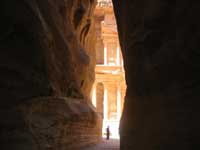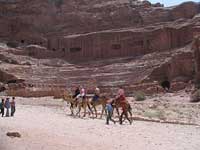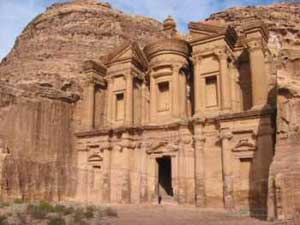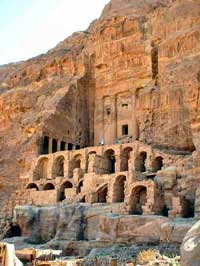Petra, Jordan
 |
| Petra Treasury
(Al Khazneh) |
Petra ( rock in Greek) is an archaeological site
in Jordan, lying in a basin among the mountains which form
the eastern flank of Wadi Araba, the great valley running
from the Dead Sea to the Gulf of Aqaba. It is famous for having
many stone structures carved into the rock. The long-hidden
site was revealed to the Western world by the Swiss explorer
Johann Ludwig Burckhardt in 1812. Its famous description "a
rose-red city half as old as time" is the final line of a
sonnet by the minor Victorian poet John William Burgon, which
won the Newdigate Prize for poetry, given at Oxford, 1845.
Burgon had not actually visited Petra, which remained inaccessible
to all but the most intrepid Europeans, guided by local guides
with armed escorts, until after World War I.
Rekem is an ancient name for Petra and appears in
dead sea scrolls (4Q462 for example) associated with mount
Seir. Additionally, Eusebius and Jerome assert that Rekem
was the native name of Petra, apparently on the authority
of Josephus.
History
The descriptions of Strabo, Pliny the Elder, and
other writers identify Petra as the capital of the Nabataeans,
Arabic-speaking Semites, and the centre of their caravan trade.
Walled in by towering rocks and watered by a perennial stream,
Petra not only possessed the advantages of a fortress but
controlled the main commercial routes which passed through
it to Gaza in the west, to Bosra and Damascus in the north,
to Aqaba and Leuce Come on the Red Sea, and across the desert
to the Persian Gulf.
Recent excavations have demonstrated that it was
the ability of the Nabateans to control the water supply that
led to the rise of the desert city, in effect creating an
artificial oasis. The area is visited by flash floods and
archaeological evidence demonstrates the Nabateans controlled
these floods by the use of dams, cisterns and water conduits.
Thus, stored water could be employed even during prolonged
periods of drought, and the city prospered from its sale.
 |
The end of the Siq |
Although in ancient times Petra might have been approached
from the south (via Saudi Arabia on a track leading around Jabal
Haroun, Aaron's Mountain, on across the plain of Petra), or
possibly from the high plateau to the north, most modern visitors
approach the ancient site from the east. The impressive eastern
entrance leads steeply down through a dark and narrow gorge
(in places only 3-4 metres wide) called the Siq (the shaft),
a natural geological feature formed from a deep split in the
sandstone rocks and serving as a waterway flowing into Wadi
Musa. At the end of the narrow gorge stands Petra's most elaborate
ruin, Al Khazneh ("the Treasury") hewn directly out of the sandstone
cliff.
 |
| Petra Amphitheatre |
A little farther from the Treasury, at the foot of
the mountain called en-Nejr is a massive theatre, so placed
as to bring the greatest number of tombs within view; and
at the point where the valley opens out into the plain the
site of the city is revealed with striking effect. Indeed,
the amphitheatre has actually been cut into the hillside and
into several of the tombs during its construction, rectangular
gaps in the seating are still visible. Almost enclosing it
on three sides are rose-coloured mountain walls, divided into
groups by deep fissures, and lined with tombs cut from the
rock in the form of towers.
It is thought that a position of such
natural strength must have been occupied early, but we have
no means of telling exactly when the history of Petra began.
The evidence seems to show that the city was of relatively late
foundation, though a sanctuary (see below) may have existed
there from very ancient times. This part of the country was
assigned by tradition to the Horites, i.e. probably cave-dwellers,
the predecessors of the Edomites (Genesis xiv. 6, xxxvi. 20-30;
Deut. ii. 12); the habits of the original natives may have influenced
the Nabataean custom of burying the dead and offering worship
in half-excavated caves. But that Petra itself is mentioned
in the Old Testament cannot be affirmed with certainty; for
though Petra is usually identified with Sela which also means
a rock, the Biblical references (Judges i. 36; Isaiah xvi. i,
xlii. 11; Obad. 3) are far from clear. 2 Kings xiv. 7 seems
to be more explicit; in the parallel passage, however, Sela
is understood to mean simply "the rock" (2 Chr. xxv. 12, see
LXX). Hence many authorities doubt whether any town named Sela
is mentioned in the Old Testament.
What, then, did the Semitic inhabitants
call their city? Eusebius and Jerome (Onom. sacr. 286, 71. 145,
9; 228, 55. 287, 94), apparently on the authority of Josephus
(Antiquities iv. 7, 1~ 4, 7), assert that Rekem was the native
name, and Rekem certainly appears in the dead sea scrolls as
a prominent Edom site most closely describing Petra. But in
the Aramaic versions Rekem is the name of Kadesh; Josephus may
have confused the two places. Sometimes the Aramaic versions
give the form Rekem-Geya, which recalls the name of the village
El-ji, south-east of Petra; the capital, however, would hardly
be defined by the name of a neighbouring village. The Semitic
name of the city, if it was not Sela, must remain unknown. The
passage in Diodorus Siculus (xix. 94-97) which describes the
expeditions which Antigonus sent against the Nabataeans in 312
BC is generally understood to throw some light upon the history
of Petra, though it must be admitted that the petra referred
to as a natural fortress and place of refuge cannot be a proper
name, and the description at any rate implies that the town
was not yet in existence. Brünnow thinks that "the rock" in
question was the sacred mountain en-Nejr (above); but Buhl suggests
a conspicuous height about 16 miles north of Petra, Shobak,
the Mont-royal of the Crusaders.
 |
Monastery at Petra |
More satisfactory evidence of the date
at which the earliest Nabataean settlement began is to be obtained
from an examination of the tombs. Two types may be distinguished
broadly, the Nabataean and the Graeco-Roman. The Nabataean type
starts from the simple pylon-tomb with a door set in a tower
crowned by a parapet ornament, in imitation of the front of
a dwelling-house; then, after passing through various stages,
the full Nabataean type is reached, retaining all the native
features and at the same time exhibiting characteristics which
are partly Egyptian and partly Greek. Of this type there exist
close parallels in the tomb-towers at el-I~ejr [?] in north
Arabia, which bear long Nabataean inscriptions, and so supply
a date for the corresponding monuments at Petra. Then comes
a series of tombfronts which terminate in a semicircular arch,
a feature derived from north Syria, and finally the elaborate
façades, from which all trace of native style has vanished,
copied from the front of a Roman temple. The exact dates of
the stages in this development cannot be fixed, for strangely
enough few inscriptions of any length have been found at Petra,
perhaps because they have perished with the stucco or cement
which was used upon many of the buildings. We have, then, as
evidence for the earliest period, the simple pylon-tombs, which
belong to the pre-Hellenic age; how far back in this stage the
Nabataean settlement goes we do not know, but not farther than
the 6th century BC. A period follows in which the dominant civilization
combines Greek, Egyptian and Syrian elements, clearly pointing
to the age of the Ptolemies. Towards the close of the 2nd century
BC, when the Ptolemaic and Seleucid kingdoms were equally depressed,
the Nabataean kingdom came to the front; under Aretas III Philhellene,
(c.85 - 60 BC), the royal coins begin; at this time probably
the theatre was excavated, and Petra must have assumed the aspect
of a Hellenistic city. In the long and prosperous reign of Aretas
IV Philopatris, (9 BC - AD 40), the fine tombs of the el-I~ejr
[?] type may be dated, and perhaps also the great High-place.
Roman Rule
 |
| Urn Tomb |
In 106, when Cornelius Palma was governor
of Syria, that part of Arabia under the rule of Petra was absorbed
into the Roman Empire as part of Arabia Petraea, and the native
dynasty came to an end. But the city continued to flourish.
A century later, in the time of Alexander Severus, when the
city was at the height of its splendour, the issue of coinage
comes to an end, and there is no more building of sumptuous
tombs, owing apparently to some sudden catastrophe, such as
an invasion by the neo-Persian power under the Sassanid dynasty.
Meanwhile as Palmyra (fl. 130 - 270) grew in importance and
attracted the Arabian trade away from Petra, the latter declined;
it seems, however, to have lingered on as a religious centre;
for we are told by Epiphanius of Cyprus (c.315 - 403) that in
his time a feast was held there on December 25 in honour of
the virgin Chaabou and her offspring Dusares.
Religion
The Nabataeans worshipped the Arab
gods and goddesses of the pre-Islamic times as well as few of
their deified kings. The most famous of these was Obodas I,
who was deified after his death. Du Sharrah was the main male
God accompanied by his feminine trinity; Al Uzza, Al Latt and
Mena. Many statues carved in the rock depict these gods & goddesses.
The Monastery, Petra's largest monument, dates from the first
century BC. It was dedicated to Obodas I and is believed to
be the symposium of Obodas the god. This information is inscibed
on the ruins of the Monastery (the name is the translation of
the Arabic "Ad-Deir").
Christianity found its way into Petra
in the 4th century CE, nearly 500 years after the establishment
of Petra as a trade center. Athanasius mentions a bishop of
Petra (Anhioch. 10) named Asterius. At least one of the tombs
(the "tomb with the urn"?) was used as a church; an inscription
in red paint records its consecration "in the time of the most
holy bishop Jason" (447). The Christianity of Petra, as of north
Arabia, was swept away by the Islamic conquest of 629 - 632.
During the First Crusade Petra was occupied by Baldwin I of
the Kingdom of Jerusalem and formed the second fief of the barony
of Kerak (in the Lordship of Oultrejordain) with the title Château
de la Valée de Moyse or Sela. It remained in the hands of the
Franks until 1189. Ruins of the Crusaders' citadel still stand
near the high-place on en-Nejr.
The first Byzantine church was discovered
by Kenneth Russell, an American archeologist, in 1991 with the
assistance of Dakihlallah, a Bedul Bedouin living in Petra.
Currently three churches have been excavated in Petra with the
assistance of the American Center of Oriental Research and the
Jordanian Department of Antiquities.
According to tradition, Petra is the
spot where Moses struck a rock with his staff, and water came
forth, and where Moses' sister, Miriam, is buried.
Decline
Petra's decline came rapidly under
Roman rule, in large part due to the revision of sea-based trade
routes. But in 363 an earthquake destroyed buildings and crippled
the vital water management system. The ruins of Petra were an
object of curiosity in the Middle Ages and were visited by the
Sultan Baibars of Egypt towards the close of the 13th century.
The first European to describe them was Johann Ludwig Burckhardt
in 1812.
Petra Today
• On December 6, 1985 Petra was
designated a World Heritage Site. A team of architects has been
(2006) set to work on a 'Visitor Centre', and Jordan's tourist
revenue is set to increase dramatically, with the mass production
of visitors on package holidays, although this is sensitive
to any hint of political instability. For example, the Jordan
Times reported in December 2006 that 59,000 people visited in
the two months October and November 2006, 25% fewer than the
same period in the previous year.
• John William
Burgon famously wrote that Petra was a "rose red city half as
old as time." Although at that time Burgon had never been to
Petra himself, the phrase has become strongly associated with
Petra. In fact the rocks of Petra are of many hues, few of which
could properly be described as "rose red".
Petra in movies and
popular culture
• David
Lean had planned to film lengthy scenes for Lawrence of Arabia
(1962) there, since T.E. Lawrence had investigated the site.
Because of budgetary limitations, however, the production pulled
out of Petra before the scenes could be shot.
• Petra
is featured in Indiana Jones and the Last Crusade as the Holy
Temple where the Holy Grail is located.
• Petra also appears
in many less distinguished films, and in popular fiction. The
site has also been used for television programmes and pop promotions.
• The independent film
Passion in the Desert used areas in Petra as a backdrop for
filming
Movies and T.V. series filmed in
Petra
• Son of God (2001) TV Series
• Terra X - Expedition ins Unbekannte" (1984) TV Series
• Indiana Jones and the Last Crusade (1989)
• Mortal Kombat: Annihilation (1997) ...aka Mortal Kombat
2
• Mummy Returns, The (2001)
• Passion in the Desert (1997)
• Sinbad and the Eye of the Tiger (1977) ...aka Sinbad
at the World's End
• Spiritual Warriors (2006)
• Xin A Li Ba Ba (1989)...aka A Li Ba Ba (1989) (USA:
video box title)
|